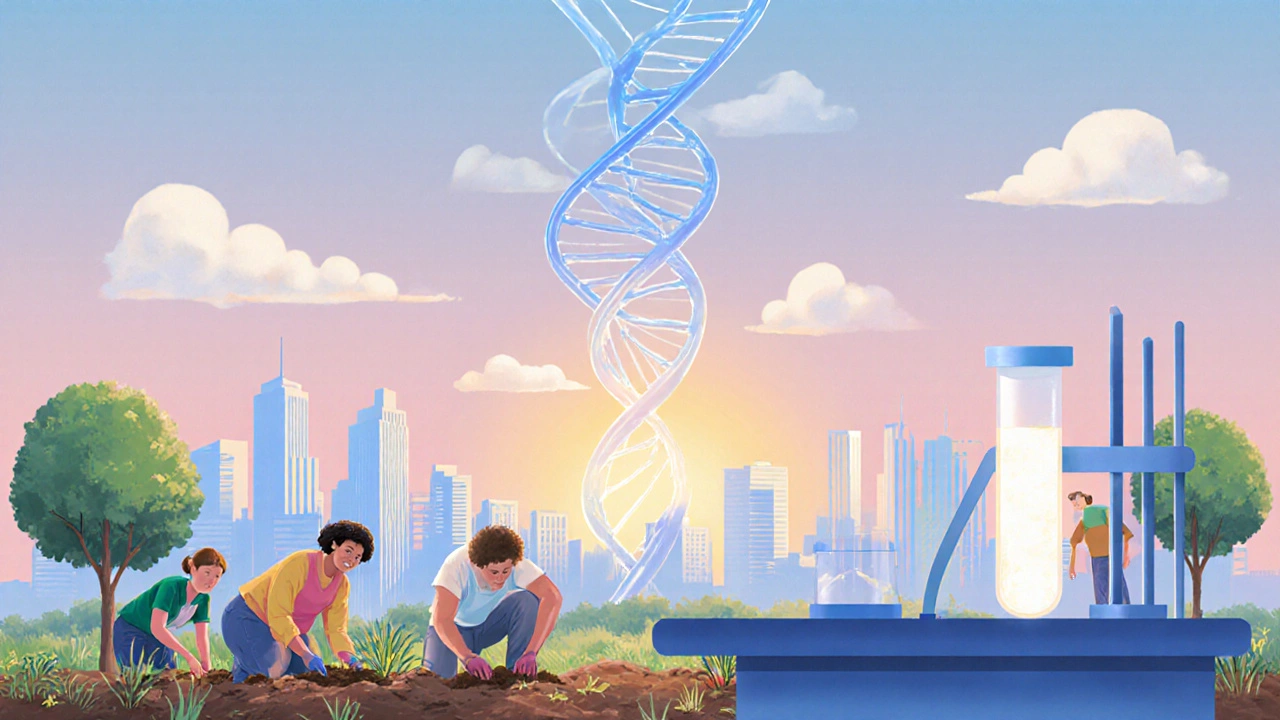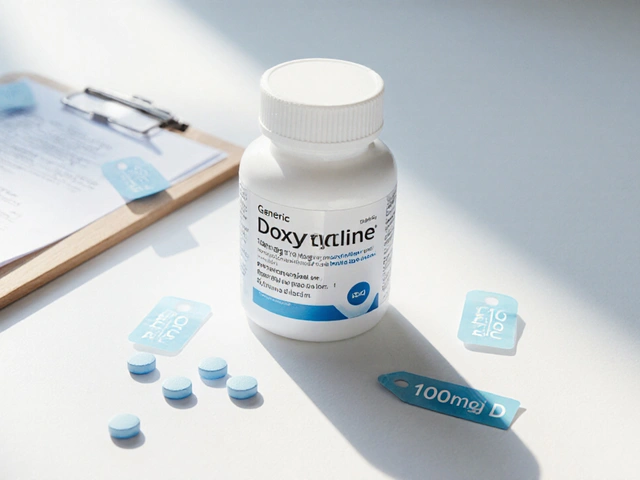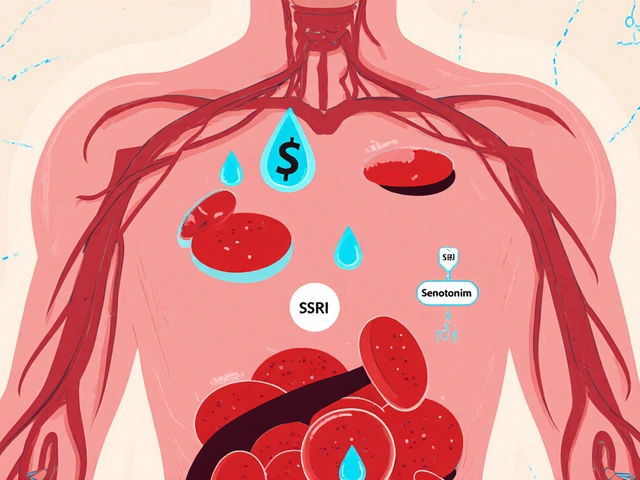
Pancreatic Cancer Risk Factor Calculator
Estimated Risk Factors
Risk Summary
Note: These are estimates based on epidemiological studies. Individual risk depends on multiple factors including genetics, lifestyle, and overall health.
Key Environmental Risk Factors
Smoking
Relative Risk: 1.5–2.0
Strong EvidenceOccupational Solvents
Relative Risk: 1.2–1.5
Moderate EvidenceAir Pollution
Relative Risk: 1.1–1.3
Moderate EvidencePesticides
Relative Risk: 1.2–1.4
Moderate EvidenceKey Takeaways
- Smoking remains the single biggest modifiable pancreatic cancer risk factor, accounting for up to 30% of cases.
- Long‑term exposure to industrial chemicals (e.g., chlorinated solvents, asbestos) and air pollutants increases risk modestly but consistently.
- Dietary contaminants such as certain pesticides and heavy metals can amplify risk when combined with chronic inflammation.
- Practicing smoke‑free living, using protective equipment at work, and supporting clean‑air policies are proven ways to cut exposure.
- Research is moving toward gene‑environment interaction studies, aiming to pinpoint who is most vulnerable.
What Do We Mean by “Environment” in Cancer Talk?
When scientists talk about the environment, they’re not just describing the weather. It covers everything outside our own bodies that can affect health - from the air we breathe to chemicals we touch at work, to the food we eat, and even the lifestyle habits that shape exposure.
For clarity, we’ll break the environment into three broad buckets:
- Physical agents - air pollution, radiation, occupational chemicals.
- Chemical agents - pesticides, heavy metals, industrial solvents.
- Behavioral agents - smoking, alcohol, diet patterns that introduce or magnify other exposures.
Each bucket can interact with genetic predispositions, creating a complex web of risk.
Understanding the Link Between Pancreatic Cancer and the Environment
Pancreatic cancer is a highly lethal cancer that begins in the pancreas, an organ responsible for producing digestive enzymes and insulin. Because symptoms often appear late, most diagnoses happen at an advanced stage, making prevention a critical public‑health goal.
Researchers have long asked whether what we inhale, ingest, or touch can tip the scales toward cancer. Large‑scale cohort studies, case‑control investigations, and meta‑analyses have gradually built a picture: certain environmental exposures do raise the odds, but the magnitude varies.
The International Agency for Research on Cancer (IARC) classifies many of these agents as Group 1 (carcinogenic to humans) or Group 2A/2B (probably/possibly carcinogenic). While most of those classifications focus on lung or bladder cancer, several have been linked specifically to pancreatic outcomes.
Major Environmental Exposures Linked to Pancreatic Cancer
| Environmental Factor | Typical Exposure | Estimated Relative Risk (RR) | Evidence Strength |
|---|---|---|---|
| Smoking | Pack‑years, active or second‑hand | 1.5-2.0 | Strong (multiple cohort studies) |
| Occupational solvents (e.g., trichloroethylene, perchloroethylene) | Industrial settings, prolonged contact | 1.2-1.5 | Moderate (case‑control + meta‑analysis) |
| Air pollution (PM2.5, NO₂) | Urban residence, long‑term exposure | 1.1-1.3 | Moderate (prospective cohorts) |
| Pesticides (organophosphates, organochlorines) | Agricultural work, contaminated food | 1.2-1.4 | Moderate (experimental & epidemiologic) |
| Heavy metals (arsenic, cadmium) | Contaminated water, occupational inhalation | 1.1-1.3 | Weak‑to‑moderate (limited cohort data) |
These numbers don't mean that everyone exposed will develop pancreatic cancer; they describe an increased probability compared with unexposed groups.
How Strong Is the Evidence?
Evidence quality varies across agents. Smoking is backed by dozens of longitudinal studies, making its link unequivocal. In contrast, the data on heavy metals rely on smaller cohorts and animal models, so conclusions are more tentative.
Scientists evaluate four pillars when judging causality:
- Temporal relationship - exposure must precede disease.
- Dose‑response - higher exposure should raise risk.
- Biological plausibility - a mechanism that can explain how the agent damages pancreatic cells.
- Consistency - similar findings across different populations and study designs.
Most environmental factors meet at least two of these criteria, which is why public‑health agencies advise precaution even when the risk increase is modest.

Practical Ways to Reduce Your Environmental Exposure
Even if you can’t control every factor, many actionable steps can lower your cumulative risk:
- Quit smoking - the single most effective prevention measure. Resources like NHS Stop Smoking services provide free counseling and nicotine‑replacement options.
- Limit second‑hand smoke - enforce smoke‑free rules at home and in cars.
- Choose safer workplace practices - if you work with solvents or metals, wear certified protective gear, ensure proper ventilation, and follow OSHA‑aligned protocols.
- Eat organically when possible - reduces pesticide residues. Washing fruits and vegetables under running water also cuts surface contaminants.
- Filter drinking water - certified carbon filters can lower arsenic and lead levels, especially in older plumbing systems.
- Support clean‑air policies - community advocacy for reduced traffic emissions and stricter industrial standards benefits everyone.
Remember, reducing exposure is about cumulative effect. Small daily choices add up over decades.
Where Is the Research Heading?
Two exciting trends are shaping the next decade of understanding:
- Gene‑environment interaction studies - Large biobanks now pair genomic data with detailed exposure histories, helping identify people who are genetically susceptible to specific chemicals.
- Biomarker development - Scientists are hunting blood‑based signatures of early pancreatic damage caused by pollutants, aiming for a screening test that could catch cancer before symptoms appear.
Funding bodies like the UK Medical Research Council and the U.S. National Cancer Institute have earmarked billions for this line of work, signaling that clearer answers are on the horizon.
Frequently Asked Questions
Is air pollution a proven cause of pancreatic cancer?
Air pollution, especially fine particulate matter (PM2.5), shows a modest but consistent rise in pancreatic cancer risk across several large cohort studies. While the increase is smaller than that seen with smoking, the evidence meets the criteria for probable causality.
Can a healthy diet offset environmental risks?
A diet rich in fruits, vegetables, whole grains, and low in processed meats can reduce chronic inflammation, which is a key pathway linking many exposures to pancreatic cancer. While diet alone won’t erase all risk, it strengthens the body’s defense mechanisms.
Are there any screening tests for people with high environmental exposure?
Currently, there is no approved population‑wide screening for pancreatic cancer, even for high‑risk groups. Research on blood‑based biomarkers and imaging in high‑exposure cohorts is ongoing, but routine screening remains experimental.
How long does it take for an exposure to affect pancreatic cancer risk?
Latency periods can span 10-30 years, depending on the agent and the individual’s genetic makeup. This long window explains why historic occupational exposures still appear in today’s studies.
Should I get genetic testing if I work with chemicals?
Genetic testing can identify mutations (e.g., BRCA2, CDKN2A) that raise pancreatic cancer susceptibility. If you have a family history of pancreatic or related cancers, discuss testing with a genetic counselor, especially if you have chronic chemical exposure.
Staying informed, minimizing avoidable exposures, and consulting healthcare providers for personalized advice are the best defense against this challenging disease.
16 Comments
Carlos A Colón
October 12 2025
Oh sure, because ignoring decades of epidemiological evidence is a brilliant life strategy, right? I feel your frustration, but the data kinda nudges us toward quitting the habit.
Aurora Morealis
October 16 2025
Smoking raises risk and chemicals add to it even if you try to downplay the evidence
Sara Blanchard
October 21 2025
We appreciate the perspective shared and want to emphasize that every community member, regardless of background, deserves clear information about environmental hazards. The calculator offers a starting point, and together we can navigate these risks responsibly.
Anthony Palmowski
October 25 2025
Wow!!! Smoking, chemicals, pollution-each adds a little, then a little more!!!
Jillian Rooney
October 29 2025
It is utterly shameful how some folks turn a blind eye to the mounting evidence, letting their own vices poison the very air we all share. Patriotic duty demands we curb these habits, yet many persist in selfish indifference, jeopardizing our nation's health.
Rex Peterson
November 2 2025
The interplay between environmental exposure and oncogenic pathways invites rigorous contemplation. One must consider not merely the quantitative risk increments but also the qualitative ethical implications of industrial practices. Moreover, the societal burden of pancreatic malignancies warrants a collective introspection. As scholars, we are called to dissect these data with judicious scrutiny. Ultimately, informed stewardship may mitigate the looming specter of disease.
Candace Jones
November 6 2025
Great job exploring the risk calculator! If you need help interpreting the numbers, feel free to ask – I’m happy to break it down step by step.
Robert Ortega
November 10 2025
While the data highlight several risk factors, it’s important to weigh them against individual lifestyle choices. A balanced view helps us avoid alarmism and encourages pragmatic health decisions.
Elizabeth Nisbet
November 14 2025
You’re doing fine, just remember that small changes add up over time.
Sydney Tammarine
November 18 2025
Ah, the melodrama of environmental doom! One merely whispers the term “pesticide exposure” as if invoking a Shakespearean tragedy, yet the common folk scoff at such grandeur. Nonetheless, the statistics remain immutable, and herein lies the irony-our collective apathy persists. :)
josue rosa
November 23 2025
It is both a privilege and a responsibility to dissect the manifold layers of environmental carcinogenesis, especially as they pertain to pancreatic pathology. First, let us acknowledge the epidemiological backbone that links chronic tobacco inhalation to an elevated relative risk, a relationship corroborated across multiple cohort studies. Second, occupational exposure to volatile organic compounds, while perhaps less conspicuous, perpetuates a subtle yet insidious contribution to oncogenic transformation within the exocrine pancreas. Third, ambient air pollution, characterized by particulate matter ≤2.5 microns, infiltrates the respiratory epithelium and systemic circulation, thereby augmenting inflammatory cascades that may predispose to neoplastic initiation. Fourth, agricultural pesticides, though designed to protect crops, possess endocrine-disrupting properties that can perturb cellular homeostasis. Fifth, the synergistic interaction among these risk vectors cannot be overstated; combined exposures often yield multiplicative rather than additive risk profiles. Sixth, genetic susceptibility, exemplified by mutations in BRCA2 or CDKN2A, modulates the penetrance of environmental insults, underscoring the necessity of a personalized risk assessment. Seventh, lifestyle modifiers such as diet, physical activity, and body mass index intertwine with environmental factors, creating a complex mosaic of risk determinants. Eighth, the public health implications are profound, demanding policy interventions that curtail emissions, enforce workplace safety, and regulate pesticide application. Ninth, clinicians must remain vigilant, incorporating exposure histories into routine oncologic screening protocols. Tenth, patient education should emphasize actionable steps, such as smoking cessation programs and the use of protective equipment in high-exposure occupations. Eleventh, research endeavors ought to prioritize longitudinal studies that quantify cumulative exposure and its temporal relationship with disease onset. Twelfth, interdisciplinary collaboration between epidemiologists, toxicologists, and molecular biologists will enhance our mechanistic understanding. Thirteenth, the ethical dimension compels us to address environmental justice, as marginalized communities often bear disproportionate exposure burdens. Fourteenth, technological innovations, including biomonitoring and exposome mapping, promise refined risk stratification. Finally, while the calculator provides a valuable heuristic, it must be contextualized within the broader tapestry of individual health determinants.
Shawn Simms
November 27 2025
The calculator presents estimates based on peer‑reviewed studies; therefore, its use should be complemented by professional medical consultation.
Geneva Angeles
December 1 2025
Let’s celebrate the fact that we now have tools to gauge our environmental risk, because knowledge is power! Yet we must not sit idle; we should aggressively advocate for cleaner air, stricter chemical regulations, and robust public health campaigns. Optimism fuels action, and together we can transform these statistics into a catalyst for change. Remember, every small victory builds momentum toward a healthier future.
Scott Shubitz
December 5 2025
Listen up! The data are screaming louder than a rock concert-smoking, chemicals, pollution-they’re all throwing punches at your pancreas. If you think you can dodge them, think again; the odds are stacked like a deck of busted cards.
Soumen Bhowmic
December 9 2025
I appreciate the thorough breakdown, and I’d love to collaborate on spreading this awareness. Perhaps we could organize a community workshop where we walk folks through the calculator step by step, discuss practical ways to reduce exposure, and share resources for quitting smoking. Working together, we can turn these numbers into actionable change.






Kristen Woods
October 8 2025
Behold, the harrowing tapestry of pancreatic peril woven by smoldering cigaretes and noxious fumes! The very notion doth stir the soul to a clamor of dread, and yet, we must confront it with regal resolve.